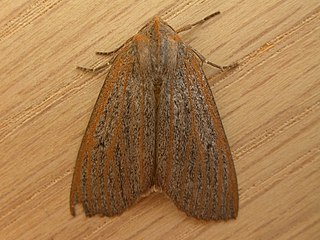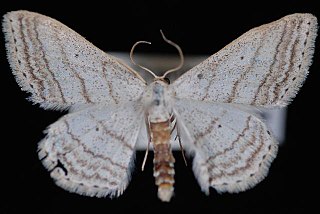| Stibaroma | |
|---|---|
 | |
| Stibaroma melanotoxa | |
| Scientific classification | |
| Missing taxonomy template ( fix ): | Stibaroma |
Stibaroma is a genus of moths in the family Geometridae described by Edward Guest in 1887. Both species are known from Australia. [1]
| Stibaroma | |
|---|---|
 | |
| Stibaroma melanotoxa | |
| Scientific classification | |
| Missing taxonomy template ( fix ): | Stibaroma |
Stibaroma is a genus of moths in the family Geometridae described by Edward Guest in 1887. Both species are known from Australia. [1]

The geometer moths are moths belonging to the family Geometridae of the insect order Lepidoptera, the moths and butterflies. Their scientific name derives from the Ancient Greek geo γεω, and metron μέτρον "measure" in reference to the way their larvae, or inchworms, appear to measure the earth as they move along in a looping fashion. A very large family, it has around 23,000 species of moths described, and over 1400 species from six subfamilies indigenous to North America alone. A well-known member is the peppered moth, Biston betularia, which has been subject of numerous studies in population genetics. Several other geometer moths are notorious pests.

Fisera eribola, the orange-hooded crest-moth, is a species of moth of the family Geometridae. It was described by Edward Guest in 1887 and it is found in Australia.

Stibaroma melanotoxa, the grey-caped line-moth, is a species of moth of the family Geometridae first described by Edward Guest in 1887. It is found in Australia.

Amelora is a genus of Lepidoptera moths in the family geometrid moths (geometridae) that reside in Australia. The Encyclopedia of Life (EOL) has identified four of its key attributes: bilateral symmetry, biting-chewing mouthparts acting as its feeding structure, having a holometabolous developmental mode, and being multicellular.

Calluga is a genus of moths in the family Geometridae.

Chlenias is a genus of moths in the family Geometridae.

Digrammia was a genus of moths in the family Geometridae erected by Carl Freiherr von Gumppenberg in 1887. It is now often considered a synonym of Semiothisa.
Drymoptila is a genus of moths in the family Geometridae.
Epicompsa is a genus of moths in the family Geometridae.

Mnesampela is a genus of moths in the family Geometridae. It was described by Edward Guest in 1887.

Nearcha is a genus of moths in the family Geometridae described by Edward Guest in 1887. All species in the genus are known from Australia.

Paralaea is a genus of moths in the family Geometridae described by Edward Guest in 1887. All the species live in Australia.

Phaiogramma is a genus of moths in the family Geometridae erected by Carl Freiherr von Gumppenberg in 1887. Markku Savela gives this name as a synonym of ChlorissaStephens, 1831.

Phelotis is a monotypic moth genus in the family Geometridae erected by Edward Guest in 1887. Its single species, Phelotis cognata, the long-fringed bark moth, first described by Francis Walker in 1860, is found in Australia.

Somatina is a genus of moths in the family Geometridae first described by Achille Guenée in 1858.

Taxeotis is a genus of moths in the family Geometridae described by Edward Guest in 1887. All the species in this genus are found in Australia.

Oenochrominae is a subfamily of the moth family Geometridae.

Scopula ancellata, the angled wave moth or pointed-winged wave, is a moth of the family Geometridae. It was described by George Duryea Hulst in 1887. It is found in North America from Quebec west to the Northwest Territories and British Columbia and south to Michigan, Indiana and Arizona. The habitat consists of mixed wood and coniferous forests.
William Warren was an English entomologist who specialised in Lepidoptera.
Caberini is a tribe of geometrid moths in the family Geometridae. There are at least 50 described species in Caberini.